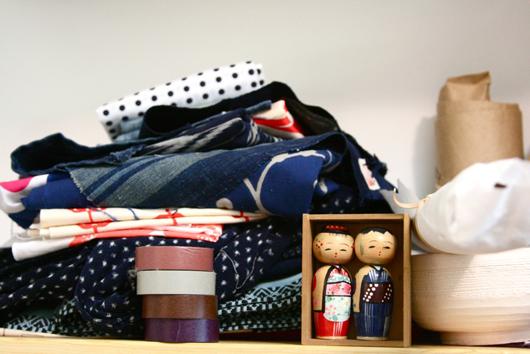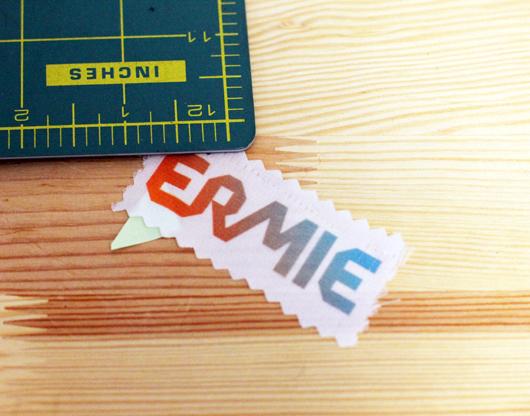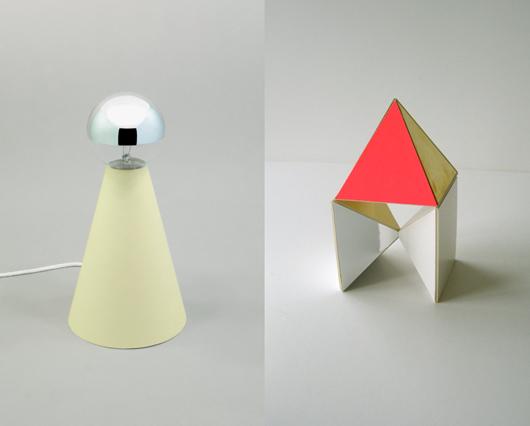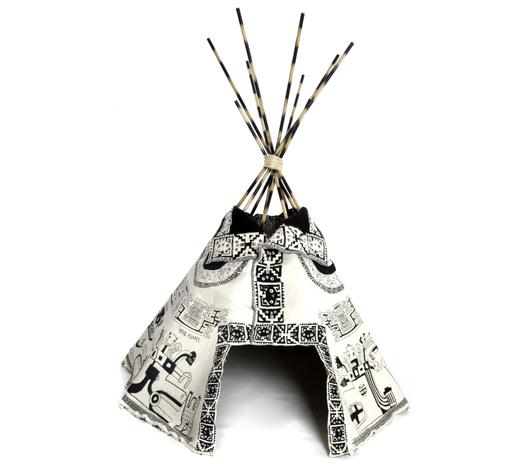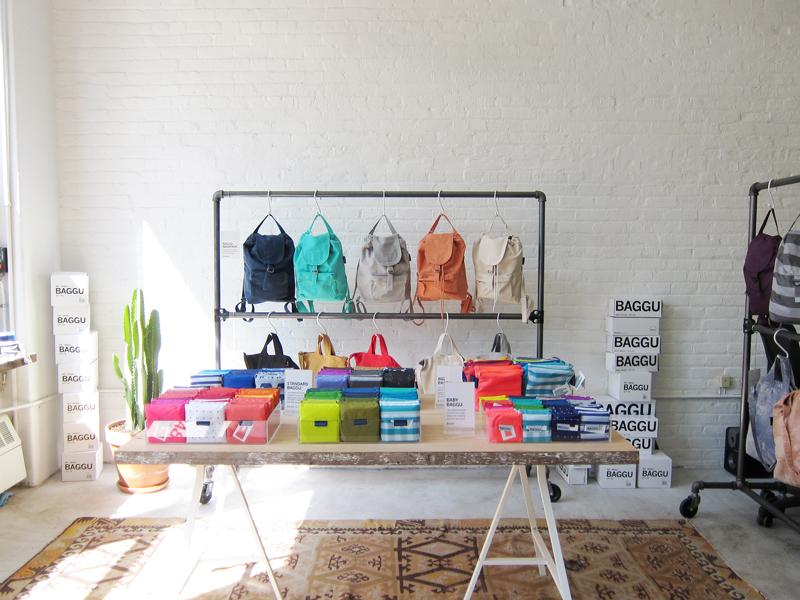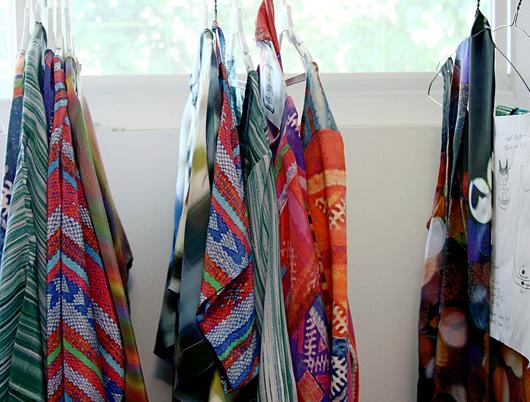
06.27.12
Studio Visit
Jennifer Parry Dodge of Ermie
Jennifer Parry Dodge is a Los Angeles–based designer, whose beautifully printed textiles are often the result of photographs or scans of vintage textiles that have been manipulated in Photoshop. Her online store Ermie, named after a great-aunt Ermengarde who encouraged her creativity, encompasses a collection of works ranging from braided embroidered belts to watery cool crepe de chine garments made from her own textile creations. In addition to creating textiles, she maintains a blog that documents her transforming fascinations with color, textures, food, the desert, and her trips abroad. The first time I met Jennifer over coffee in downtown Los Angeles, I was immediately struck by the intensity of the colors in her work — colors that vibrated in the California sun, and intensified as the sun grew stronger.
“Each pattern or print that I design has a history, however brief, of how it came to be. I’m sure the meaning for me differs from that of the viewer/ wearer/ user, but I hope some of the story comes through.”
One design, she explained, was a pixelated image of a fashion runway show. She photographed the screen then worked in Photoshop, pixelating the images, creating a new sense of color and rhythm. Another textile she showed me was inspired by a photograph of a shadow on the bedroom wall of her Highland Park home.
Jennifer was born and raised in Iowa. She attended the Minneapolis College of Art and Design and graduated with a BFA in Fine Arts Printmaking in 1995, and eventually moved to Los Angeles where she currently lives with her husband Tomory Dodge, a painter.
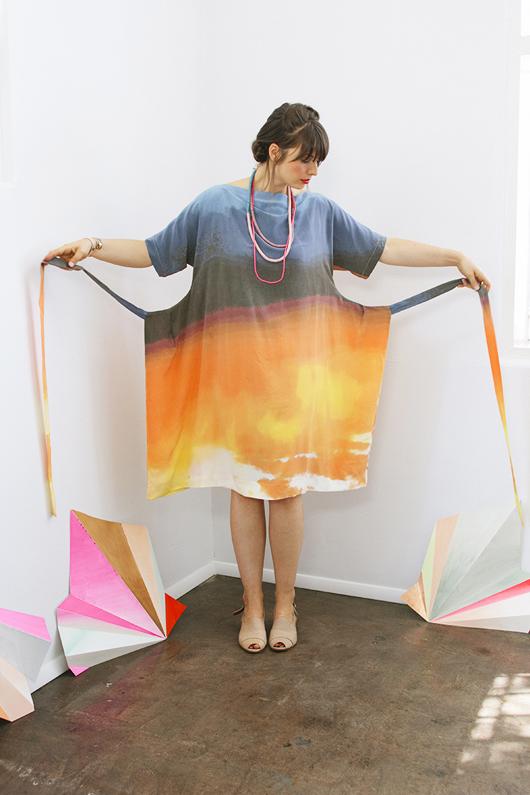
Photo: Kate Miss. Model: Lauren Spencer King. Hair & Makeup: Beatrice Valenzuela. Works on paper: Lauren Spencer King.
Probably the most striking thing about your garments is their use of color. How do you approach your palette?
In art school I was really taken with the color theory and work of Josef Albers. It was fascinating to see how a color could completely change in tone and vibrancy, depending on which color it was placed next to. It seemed quite magical at the time, making that discovery.
I use a lot of complimentary and contrasting colors in my work. I think in terms of “warm” and “cool” colors, and seeing how a print changes when those qualities are applied. The Light of California Print from my new collection (above) is a good example, showing a transition from warm to cool, orange to blue. It’s basically a photo of the sunset that I snapped from our front yard one evening, but it was also inspired by a Kaspar Lerch video by the same name.
The color in my work is also influenced by living in Los Angeles — even if only for practical reasons. It’s so warm here most of the year that wearing black from head to toe is unbearable. Since l moved here, my wardrobe has become more expressive. I live in a predominately Latino neighborhood, and when I walk down my street there is vivid color and pattern everywhere, from the murals painted on the storefronts, to the piñatas displayed in store windows. When I visit New York, I find myself wearing more black and more conservative prints and garments. If I lived there, I think I’d be working with a more restrained palette.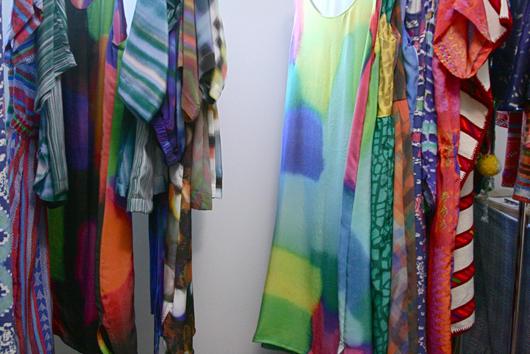
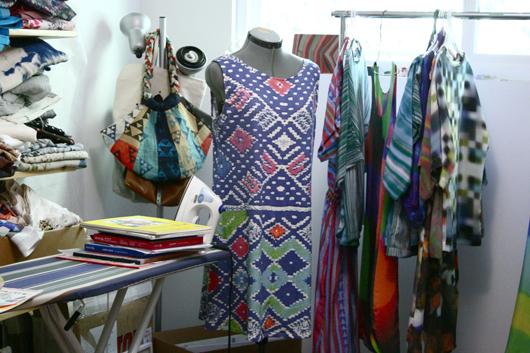
Are you a traditional pattern maker?
I never formally trained as a surface or textile designer, but I did attend art school and I have a degree in fine-art printmaking — etching, screen printing, lithography, that sort of thing. I always felt all of that was really just an extension of drawing — a different way to make different types of marks. I appreciated the tradition and admired the people I knew who became master printers because it is such an incredible skill, but I never enjoyed editioning work. I made a lot of monoprints and one-of-a-kind artist books, incorporated printmaking techniques into the paintings and drawings I was making at the time.
I only started using Photoshop this past summer, and I haven’t yet learned how to use Illustrator. At times I feel I should have gone back to school to formally study textile and surface design or fashion, but the idea of being in school for another four years at my age is not something that I interests me. I think my lack of training presents interesting challenges at times, but I also think it’s an advantage. Not knowing the rules, I have less fear. If I knew all of the things I “should” be doing, I think I’d actually accomplish less.
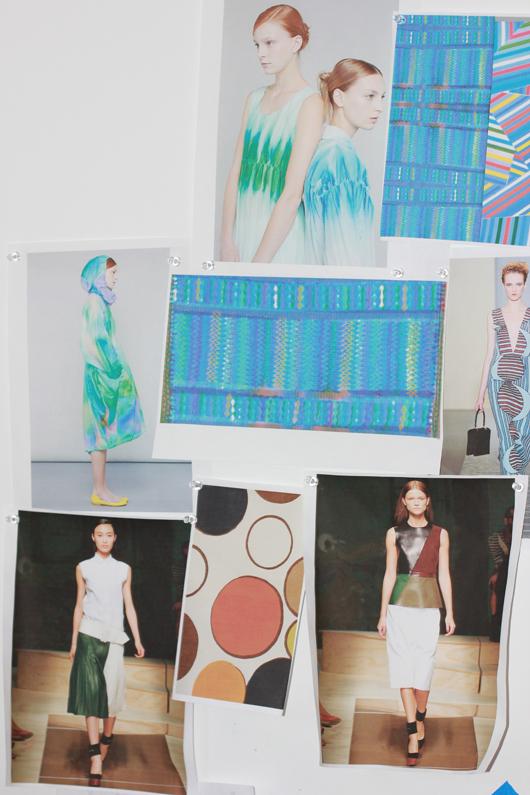
You took up textile design only recently. What were you doing before then?
I was a psychiatric nurse for about three years. I initially studied art, and I worked so many random jobs after art school but most barely paid a living wage. The last straw was when my husband Tomory and I moved to Valencia, California, so he could attend grad school at Cal Arts. I ended up working for a cruise line booking cruises. It was the worst job ever, and I felt like my life was being wasted. I had always thought about nursing as a career choice in the back of my mind; my cousin Mickey is a nurse, and he, like me, was very close to my Aunt Ermie. He encouraged me to look into nursing. I felt if I spent my time helping others, at least my time would be well spent. I quit my job at the cruise line and went back to school to study nursing, eventually earning a degree from Mount St. Mary’s in Los Angeles through their accelerated Bachelor of Science in Nursing program. I loved the courses in Biology, Anatomy and Physiology, especially Microbiology. I feel that an affinity for that course work ties into a general love for the natural world that I hold. Patterns and inspiration can be found all around in nature. I have been tempted many times to do a print based on bacteria!
I started my blog in 2008, taking photographs, and experimenting with hand-printed textiles as a creative exercise and release from my work as a nurse.I believe I was a good nurse and helped many people, but I cared too much, and I couldn’t let work go after getting home from my job. I quickly burned out of course, and decided to pursue textile design for a while — almost like art therapy for what I had experienced as a psych nurse.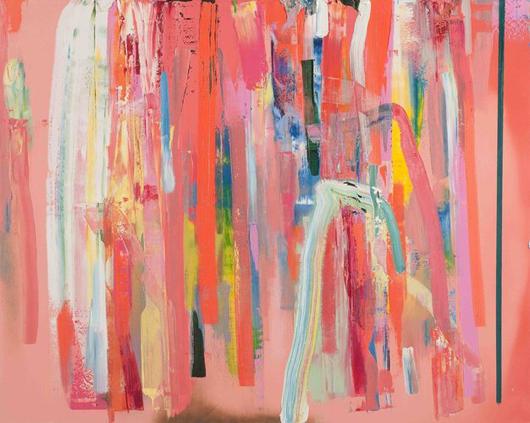
Reptile House, 2011, by Tomory Dodge. Photo (c) Robert Wedemeyer, courtesy of the Alison Jacques Gallery
Your husband Tomory Dodge is a painter. How does your work reflect each other?
I’m definitely influenced by Tomory’s work. I would say we’ve collaborated on prints, but that mostly entails me going to his studio and poking around. Of course his paintings are influential but often I’m just as attracted to the things that he’s discarded, or to his preparatory work. The first print we did together (the Magic Marker print) came about because I noticed a series of studies of compositions for these mirror image paintings he was working on. They were on tracing paper, drawn simply in red and blue Sharpie. He had dozens of those drawings, tacked up on the wall, stacks of them laying around. I immediately thought they would make a great print. Luckily, he agreed. He has told me that he’s influenced by my photography, but honestly it’s not something that we’ve extensively discussed. We respect and admire each other’s work.
Any textile artists who motivate you to work harder?
Caitlin Mociun and Lina Rennell were initial influences on my work as a textile designer. I still deeply admire their work. Akira Minagawa (Mina Perhonen) is always an inspiration. Recently, I’ve been looking at and thinking about the work of Mary Katranzou, Correll Correll, Zandra Rhodes, and Celia Birtwell. I just discovered the work of Bethan Laura Wood and I’m somewhat obsessed! Ilana Kohn and Shara Lotfi are both young, emerging designers who I think make fantastic work. Kristen Dickson (Rowena Sartin) and Lizz Wasserman (Popomomo, Curatorial) are two more established independent L.A. designers, who consistently make inspiring garments and objects. Most of my friends are artists and designers. I’m constantly impressed by their dedication, motivation, and output.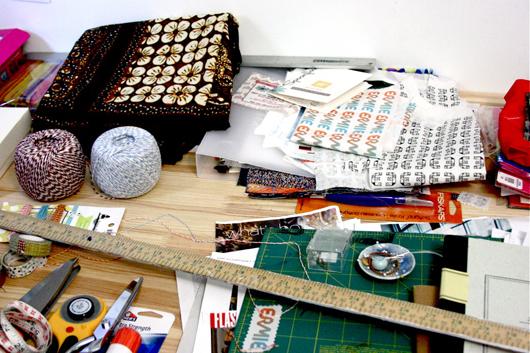
How do you arrive at certain patterns?
Most of my prints come out of everyday moments — ordinary occurrences like driving in a car or walking down the street, which can become art. One print came from noticing how light filtered through the quince bushes outside our bedroom windows. I was in bed early in the morning and snapped a photograph of that. Another originated from a photograph of shadows on the sidewalk cast by a neighbor’s plants. Yet another was developed from a photograph I took of the sky, road tripping in Colorado.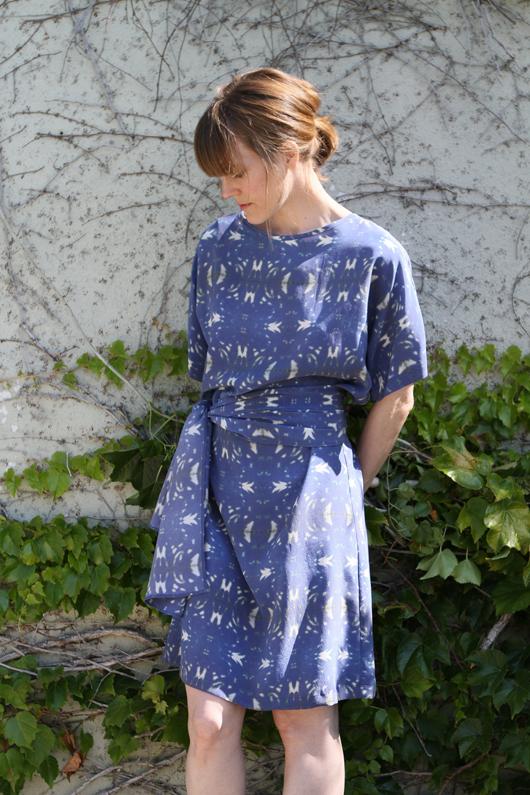
Ave. 51 print. Photo: Jeana Sohn. Model: Katie Hanburger.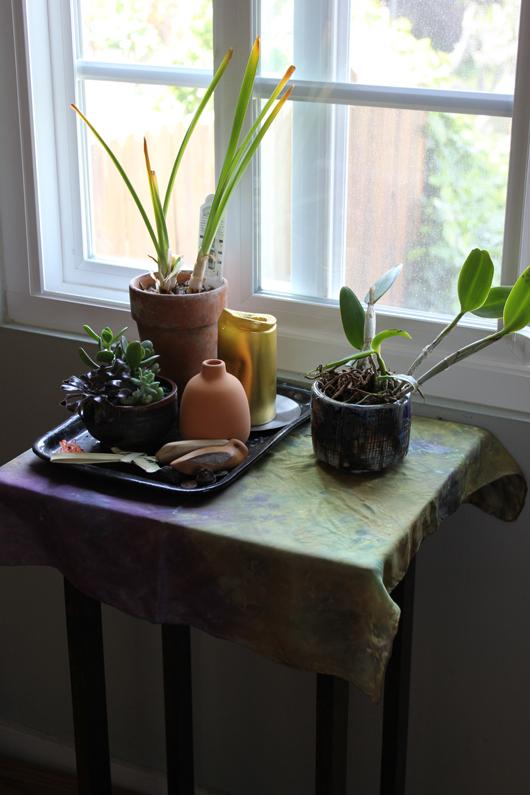
You recently went to Joshua Tree. Are you inspired by the desert?
The California desert — and Joshua Tree specifically — are probably the closest things in my life to a church. I spend time there at least once a year, and Tomory and I were married in Twenty Nine Palms. I feel recharged creatively and spiritually after my visits there. My FW ’11 collection was definitely influenced time spent in the desert. Many of those textiles and garments were designed as outfits that I personally would want to wear in the desert. For example, with the Topanga Dress (below) I was thinking about making something caftan-like — loose, and non-restrictive — that you could throw on to protect you from the sun and keep you cool while lounging poolside and to keep you warm once the sun goes down. The temperature in the desert can change quite drastically, and natural fabrics do such a good job of adapting. The colors of this dress are very desert inspired — ochre yellow, red-orange, browns, cactus green, and the blue of a night sky unpolluted by city lights.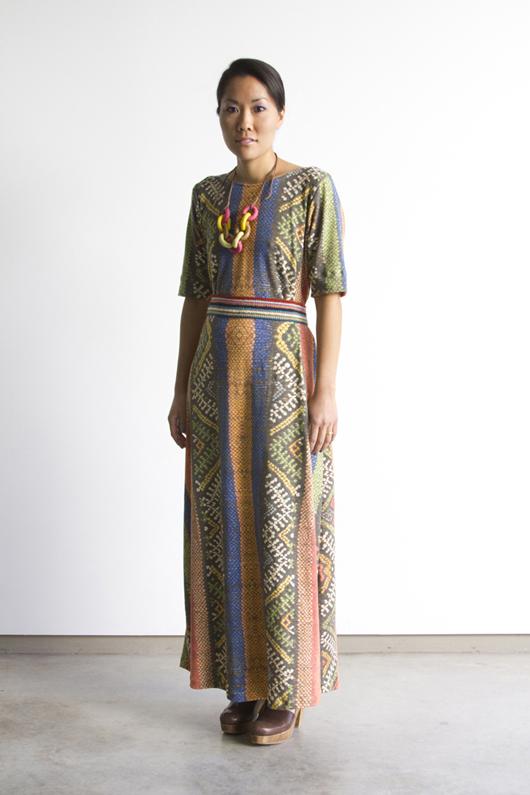
Topanga dress. Photo: Kate Miss. Model: Melanie Nakaue. Belt: Cheryl Cambras. Necklace: Melanie Nakaue.
Define “beauty” for me.
Beauty is simple, imperfect, impermanent, and unconventional. Beauty is found in unexpected places. It can originate from ugliness. True beauty is rare.
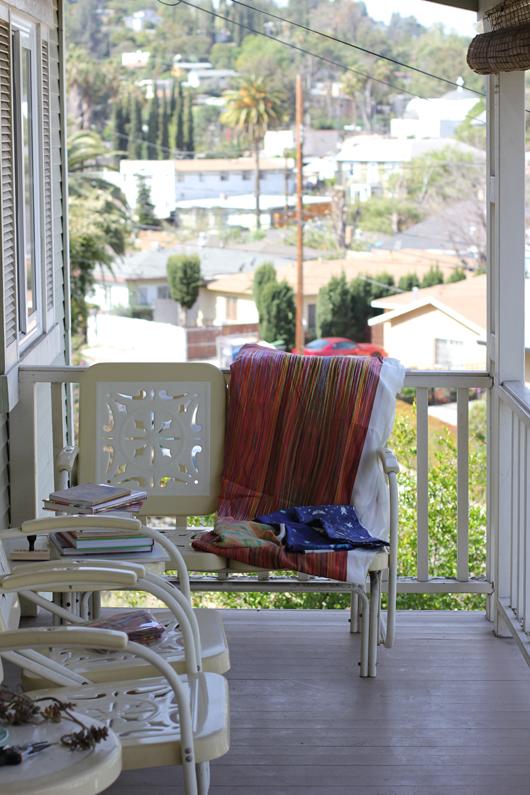
What’s the most inspiring book you’ve ever read?
In art school, I loved Musa Mayer’s memoir about her father, the painter Philip Guston. When I was in high school I devoured all of Salinger’s books; I’ve probably read Franny and Zooey 10 times over. But as a child, my favorite book was called the Witch’s Magic Cloth (written by Miyoko Matsutani, and wonderfully illustrated by Yasuo Segawa). The weird thing is I was only 1 when I was given that book, but it included subject matter — like Japan and textiles — that I’m still fascinated by today!